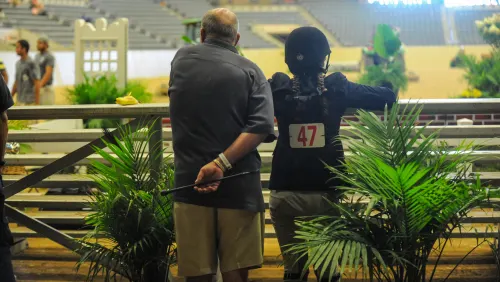 A few weeks ago, we ran a profile of Jim Hagman, a very successful hunter/jumper trainer from California (see July 8, p. 12). In reading the article, I was struck by Hagman’s description of his early years riding. He grew up on a ranch, and while he showed hunters and jumpers as a junior, he also rode Western stock horses and did gymkhana games. He also groomed, fed and cared for his own horses.
A few weeks ago, we ran a profile of Jim Hagman, a very successful hunter/jumper trainer from California (see July 8, p. 12). In reading the article, I was struck by Hagman’s description of his early years riding. He grew up on a ranch, and while he showed hunters and jumpers as a junior, he also rode Western stock horses and did gymkhana games. He also groomed, fed and cared for his own horses.
In reading about this versatile horseman, I began to realize just how few junior riders I’ve interviewed in my years at the Chronicle could relate to these kinds of stories–I can probably count them on one hand. The vast majority of them talk about growing up riding ponies, showing heavily, and learning how to ride purely in the show ring/lesson setting, with winning ribbons as their goal. But I’ve spoken to many trainers, and professional riders, who grew up pulling themselves up by their bootstraps, learning from rogue ponies and bombing around the countryside.
When I was grooming on the A-rated circuit, years ago, I worked for a top trainer who didn’t have a privileged background, had spent time teaching himself, and had a varied riding background, including time in the hunting field. He could wrap, braid and muck just as well as I could. In contrast, one of the junior riders whose horse I cared for couldn’t put a bridle on. It seems as though the current generation of trainers are the last ones who forged their talents in a variety of disciplines, with a less disciplined, more spontaneous, and better-rounded education.
ADVERTISEMENT
I know that there are many talented junior riders who’ve paid their dues at the lower levels, learned from tough ponies, taken care of their horses, and ridden by the seat of their pants. But they’re an ever-shrinking minority, I think. At the bigger shows, those who either have the wherewithal to buy strings of high-class horses or are the child of a trainer and have been born into the sport dominate the junior ranks. It used to be a lot easier to make your way into the upper echelons of the sport–now it seems as if you have to start at the top. Showing has become such an industry that it seems impossible to most to take a genuine, but not fancy, horse from your backyard and compete, let alone win, in A-rated shows. Junior riders now frequently have multiple hunters, an equitation horse or two, and a few jumpers.
And what does this foretell for the future of the sport? If the future generation of trainers are those who have grown up just riding around rings, showing 48 weeks of the year, and have never been exposed to other disciplines, nor had to learn how to hang on to a mischievous pony galloping across a field, what are they going to teach the next generation of juniors? It seems as though we’re headed toward a world where riders are brought up through the ranks knowing just how to present the perfect hunter, equitate to a “T”, and ride a fast jump-off round–but not how to relax and have fun on a horse. The onus is on the trainers of today–strive to create well-rounded horsemen like yourselves, rather than just show riders.
Yes, with the increasing lack of open space to ride and the demanding show schedules of today, it’s difficult to create opportunities for young riders to get out of the ring and cowboy around a little. But it’s essential that someone do just that.














